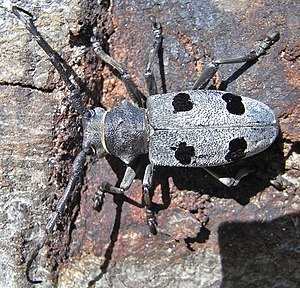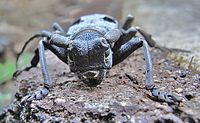Mourning goat
| Mourning goat | ||||||||||||
|---|---|---|---|---|---|---|---|---|---|---|---|---|

Mourning goat |
||||||||||||
| Systematics | ||||||||||||
|
||||||||||||
| Scientific name | ||||||||||||
| Morimus asper funereus | ||||||||||||
| Mulsant , 1862 |
The mourning Bock ( Morimus asper funereus ) is a beetle from the family of the longhorn beetle and the subfamily Lamiinae . Traditionally, the mourning buck is regarded as the species Morimus funereus , according to a more recent view it is classified as a subspecies Morimus asper funereus of the species Morimus asper . The mighty beetle resembles an oversized Herophila tristis .
Comments on the name and system
The description by Mulsant 1862/1863 is considered to be the first description of the taxon considered here as a subspecies . Mulsant classifies the beetle as a species in the already existing genus Morimus under the name Morimus funereus . Mulsant himself gives Lamia tristis Fabr. And Morimus tristis Muls. as older synonyms. It can be assumed that descriptions of the distinctive beetle also exist which precede the use of binomial nomenclature . The species name "asper" ( Latin ) means "rough" and refers to the surface texture of the exoskeleton. The German name "Trauerbock" results from the translation of the Latin funereus, which refers to things belonging to the funeral .
The generic name "Morimus" is from Altgr. μόριμος, mórimos "destined to die" derived. The genus is represented in Europe by two or three species, according to the classification as a species or subspecies, and worldwide by around twelve species.
Characteristics of the beetle
The stately beetle reaches a body length of 20 to 38 millimeters. All parts of the body are robust and heavily sclerotized . The body is elongated oval and black, but appears silver-gray because of the very short gray-white hair ( tomentation ). The antennae are particularly impressive in the male, where they protrude significantly beyond the body length (Fig. 3).
The head is inclined downwards orthogonally to the body axis. The mouthparts point vertically downwards, the last link of the jaw probe is spindle-shaped and pointed and not truncated at an angle. The first sensor element is provided with a crescent-shaped bar in front of the end, from which the first sensor element is flattened inwards towards the deflection of the second sensor element (Fig. 6 and Fig. 5). In the similarly drawn Herophila tristis , which also has a crescent-shaped bar on the 1st antennae, the first antennae is longer than the third, while the third antennae is significantly longer than the first in the weeping ram (Fig. 5). As with most longhorn beetles, the second antennae is short. The remaining of the 11 antenna elements taper increasingly towards the outside. In the female the antennae barely reach the end of the body, in the male they can reach one and a half times the body length. They are thus significantly longer than in Herophila tristis . The kidney-shaped compound eyes encompass the antenna base from behind in such a way that the distance between the bases of the two antennae on the forehead is greater than the distance between the inner edges of the eyes (visible in the taxo image).
The pronotum is drawn out laterally to a strong, blunt hump about halfway along. It is wrinkled and without this hump it is about the same length as it is wide, a little narrower than the head and narrower than the elytra .
The wing covers are fused together. At the rear end they are rounded together oval. Each wing cover has two velvety black spots, the front slightly smaller and in front of the middle, the second slightly wider in the last third. The drawing can vary, however, and there are occasional other small spots. With the exception of the black spots, the elytra are coarse-grained; on closer inspection, the grains can be seen as black spots with the naked eye. This grain is missing in the black spots (Fig. 7).
The legs are very sturdy. The fore leg has a flat longitudinal groove on the underside, which runs obliquely outwards near the tarsus (Fig. 8). The five-limbed tarsi appear four-limbed (pseudotetrameric), since the fourth limb is very small and hidden between the lobes of the third limb. The front rails have a sloping longitudinal groove on the inside (Fig. 8).
biology
The warmth-loving species is mainly found in light deciduous and mixed forests, often on freshly felled wood or on tree stumps. The adult beetle appears in May and June. It is nocturnal, but can already be found towards evening and occasionally remains open at the breeding trees during the day.
The larva develops in the trunk or in stumps of old trees, mainly beeches and oaks . The wood must not be too dry and not debarked. The larva takes several years to develop. The species can be carried off accordingly and individual finds can therefore usually not be taken as proof that the beetle is at home in the find area.
distribution
The distribution area stretches in southern Europe from Italy to Greece , to the north the distribution limit runs through Austria , the Czech Republic , Slovakia , Hungary and Romania .
literature
- Heinz joy, Karl Wilhelm Harde, Gustav Adolf Lohse (ed.): The beetles of Central Europe . tape 9 . Cerambycidae Chrysomelidae . Spektrum Akademischer Verlag, Munich 1999, ISBN 3-8274-0683-8 (first edition: Goecke & Evers, Krefeld 1966).
- Adolf Horion: Faunistics of the Central European Beetles, Bd. XII . Überlingen-Bodensee 1974
- Klaus Koch : The Beetles of Central Europe . Ed .: Heinz Freude . tape 3 : ecology . Goecke & Evers, Krefeld 1992, ISBN 3-87263-042-3 .
Web links
- Morimus funereus inthe IUCN 2013 Red List of Threatened Species . Listed by: World Conservation Monitoring Center, 1996. Retrieved February 25, 2014.
Individual evidence
- ↑ a b Morimus asper funereus in Fauna Europaea. Retrieved December 9, 2010
- ^ E. Mulsant: Histoire naturelle des Coléoptères de France Paris 1862–1863 Species p.279
- ↑ Sigmund Schenkling: Explanation of the scientific beetle names (species)
- ↑ Sigmund Schenkling: Explanation of the scientific beetle names (genus)
- ^ Morimus in Fauna Europaea. Retrieved February 24, 2013
- ↑ Morimus at BioLib







